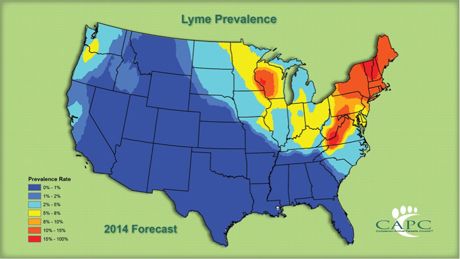Companion Animal Parasite Council Forecast Map 2014Lyme
The CAPC Parasite Forecast Maps track millions of data points and factors such as temperature, elevations, precipitation, and population density to predict the risk of vector-borne diseases. This update on Lyme give you the key findings.

Lyme disease is found in more areas than ever before. The vector ticks Ixodes scapularis and Ixodes pacificus, are expanding their range and bringing disease with them. By tracking key factors, the CAPC Parasite Forecast Maps are watching this expansion and providing new information annually.
Key facts:
> Transmission is expanding westward from the historic focus in the northeastern United States, involving more areas of Appalachia
> The normal level of activity is predicted for the Mid-Atlantic States and the upper Midwest, although evidence of transmission continues to expand southward
> Southern New England and the Pacific Coast continue to be key hotspots of activity, and are likely to experience increased number of cases elevated rates of transmission with increasing infection levels
About the maps
CAPC has been collecting data and developing the CAPC Parasite Forecast Maps since 2011.The methodology is similar to that used by NOAA for hurricane forecasts. Millions of data points are tracked and combined with factors such as temperature, elevation, precipitation and population density to predict the risk of vector-borne diseases. The CAPC Parasite Forecast Maps provide veterinarians with a client education tool to support year-round protection against parasites. To see the 2014 CAPC Parasite Forecast Maps and learn more about Lyme disease, go to capcvet.org.